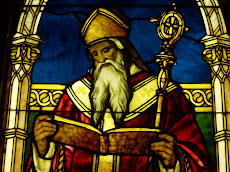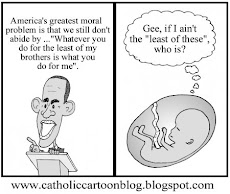This is ch. 3 of part I, "From the Old Testament to the New: The Fundamental Form of the Christian Liturgy - Its Determination by Biblical Faith." This is the third chapter of the book and the end of Part I: "The Essence of the Liturgy."
This chapter is packed with biblical theology and argues that Chirstian worship must be understood as what the Church does to celebrate the faith of the New Testament as understood as the fulfillment of the Old Testament. Liturgy is not merely copying Old Testament forms as if the Incarnation had never happened, but it is understands the Incarnation as the fulfillment of the faith of the Old Testament rather than as something new and unexpected in history. Christian worship is true worship, as opposed to pagan worship, which was futile. Yet what pagan, OT, NT and contemporary worship have in common is "the attempt to be found at every stage of history, to overcome guilt and bring back the world into right order." (35) Yet, apart from Christ "an immense feeling of futility pervades everything."
Sacrifice is at the heart of worship. Pagan worship seems to recognize this with human sacrifice, but actually human sacrifice is the evasion of the true gift of self, which is true sacrifice. In all sacrificial systems, including that of the OT, representation is at the heart of it, yet representation always falls short. What then diffrentiates Israel's worship form paganism? Firstly, it is the One to whom it is directed. Paganism worships lesser powers; Israel knows the True God who alone is Creator and Lord. Secondly, Israel's worship leads directly to Jesus Christ by its inner logic. As Benedict XVI puts it: "The NT corresponds to the inner drama of the Old." (37)
Interpreting Leviticus in the light of the crucial chapter 26, which threatens Israel with exile, prevents us from understanding the sacficial system as "an eternally valid form of worship." (37) Instead, the sacrificial system is historical and directed toward the future. Two foundational texts that establish this trajectory are Abraham's willingness to sacrifice Isaac in Genesis and the Passover in Exodus. The sacrifice of Isaac establishes representative sacrifice by divine command as eschatological expectation. This hope is fulfilled in the Lamb, "who comes from God and is for that very reason not a replacement but a true representative, in whom we are ourselves are taken to God." (38) Although Benedict XVI fails to say so in so many words, it is an obvious development of this line of thought that Christ unifies the sacrifice of self with human sacrifice insofar as in his humanity he represents us. We are incorporated into him and thus we are able to give our lives to God and receive them back in resurrection. This kind of thinking underlies Rom. 6:1-10.
The Passover reveals the lamb who is the ransom through which Israel is delivered. Throughout the OT we see that "Its sacrificial system is constantly accompanied by prophetic disquiet and questioning." (39) In I Sam. 15:32 we read "More precious than sacrifice is obedience, submission than the fat of rams!" and this is echoed in Hosea 6:6 and in the words of Jesus: "I desire mercy and not sacrifice." (Mt. 9:13 12:7) The radical critique of the Temple offered by Stephen builds on Amos 5:21-23 and Jesus' predcition of the destruction of the Temple. Benedict XVI writes:
"The essential work of Moses was the construction of the tabernacle and the ordering of worship, which was also the very heart of the order of law and moral instruction. If this is so, then it is clear that the new Prophet, the definitive Prophet, will lead the people out of the age of the tabernacle and its impermanence, out of all the inadequacy of sacrifical animals. He will 'destroy' the Temple and indeed 'change the customs that Moses had delivered. The prophets who followed Moses were the great witnesses to the impermanence of all these customs. Raising their voices they pushed history forward to the New Moses." (42)
Jesus' prediction of the destruction of the Temple is a prophecy of the Cross and the Resurrection is the beginning of the new Temple, which is the body of Christ. Benedict XVI notes: "Interpreted at its deepest level, the prophecy of the Resurrection is also a prophecy of the Eucharist. The body of Christ sacrificed and precisely as sacrificed is living." (43)
With no Temple, "the sacrifice is the "word," the word of prayer, which goes up from man to God, emobdying the whole of man's existence and enabling him to become 'word' (logos) in himself. It is man, conforming himself to logos and becoming logos through faith, who is the true sacrifice, the true glory of God in the world." (46) However, disembodied prayer is insufficient:
"The Word alone is not enough."
The experience of Israel in exile coming to God with empty hands, only prayer, and the philosophy of logos in the Greek world are both incorporated into Christian worship. However, just as the Word alone in Exilic worship is not enough: "the Hellenistic Logos-Mysticism, however grand and beautiful, allows the body to fall into insubstantiality." This Word or Logos alone worship is Gnostic. Benedict XVI then writes:
"The idea of the sacrifice of the Logos becomes a full reality only in the Logos incarnatus, the Word who is made flesh and draws 'all flesh' into th glorification of God. . . The two themes that Psalm 51 could not reconcile, the two themes that throughout the OT keep running toward one another, now really converge. . . In Jesus' self-surender on the Cross, the Word is united with the entire reality of human life and suffering. There is no longer a replacement cult. Now the vicarious sacrifice of Jesus take us up and leads us into that likeness with God, that transformation into love, which is the only true adoration." (47)
So the Eucharist is the focal point where all the lines meet. "Here at last is right worship" says Benedict XVI. "In the pierced heart of the Crucified, God's own heart is opened up - here we see who God is and what he is like." (48)
In summing up this rich and profound chapter, Benedict XVI makes four points.
1. Christian worship cannot be viewed simply as a Christianized form of the synagogue service even though its form owes much to the synagogue service. The synagogue was always oriented toward the Temple and Christian worship embodies the fulfillment of the Temple by the true sacrifice of the Eucharist. Whereas liberal theology sees the "Word alone" worship of the synagogue as an advance in the history of religion over the sacrificial system of the Temple, Christian worship does not. Where I wrote "liberal" in the previous sentence I almost wrote "Protestant" but I'm not willing to concede that point yet. Protestant worship certainly tends toward Gnosticism and man-centered moralism, but need not do so. But in order to avoid going off the rails here, Protestant theology must listen humbly to the Church Catholic speaking through the mouth of Benedict XVI.
2. Christian worship is universal worship: "to celebrate the Eucharist means to enter into the openness of a glorification of God that embraces both heaven and earth, an openness effected by the Cross and Resurrection. (49)
3. Divine worship is the confluence of several streams: the spiritual movement of the OT, the process of inner purification within the history of religion, human quest, and divine response. "The logos of creation, the logos in man, and the true and eternal Logos made flesh, the Son, come together." (50) All this is implied in the term "Eucharist," compared to which the terms "meal" or "assembly" are inadequate by comparison. "Eucharist points to the universal form of worship that took place in the Incarnation, Cross and Resurrection of Christ." (50)
4. Christian liturgy is a liturgy of hope; it is a quest for a goal. The new Temple is under construction but has not yet been revealed in its glory. "Christian liturgy is liturgy on the way, a liturgy of pilgrimage toward the transformation of the world, which will only take place when God is 'all in all.'" (50) We look forward to the day when the Heavenly Jerusalem comes down to earth and the whole creation is turned into the Temple of God.
Subscribe to:
Post Comments (Atom)





No comments:
Post a Comment